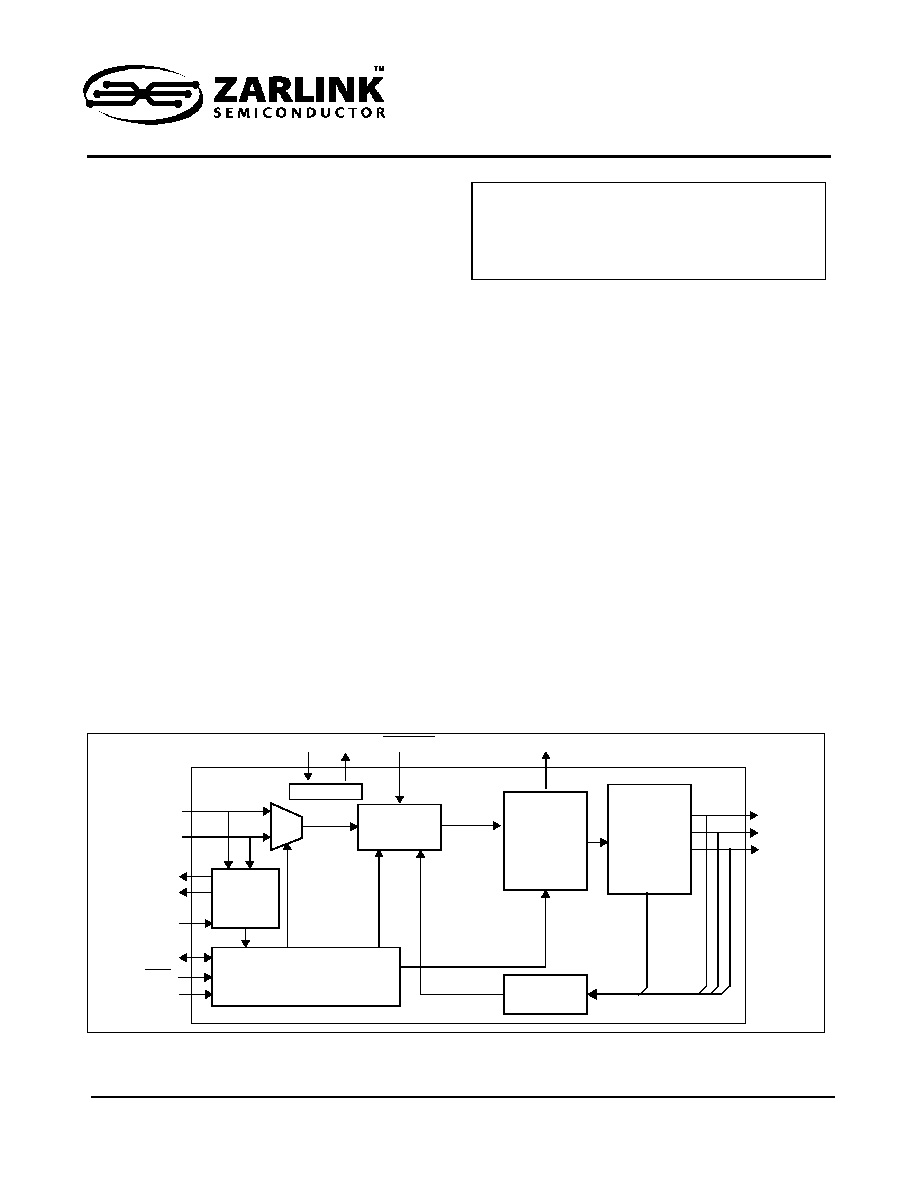
1
Zarlink Semiconductor Inc.
Zarlink, ZL and the Zarlink Semiconductor logo are trademarks of Zarlink Semiconductor Inc.
Copyright 2004, Zarlink Semiconductor Inc. All Rights Reserved.
Features
� Supports output wander and jitter generation
specifications for GR-253-CORE OC-3 and G.813
STM-1 SONET/SDH interfaces
� Accepts two input references and synchronizes to
any combination of 2 kHz, 8 kHz, 1.544 MHz,
2.048 MHz, 8.192 MHz, 16.384 MHz or 19.44 MHz
inputs
� Provides a 19.44 MHz (SONET/SDH) clock output
� Provides an 8 kHz framing pulse and a 2 kHz
multi-frame pulse
� Provides automatic entry into Holdover and return
from Holdover
� Hitless reference switching
� Provides lock and accurate reference fail
indication
� Loop filter bandwidth of 29 Hz or 14 Hz
� Less than 24 ps
rms
intrinsic jitter on the 19.44 MHz
output clock, compliant with GR-253-CORE OC-3
and G.813 STM-1 specifications
� Less than 0.5 ns
pp
intrinsic jitter on output frame
pulses
� External master clock source: clock oscillator or
crystal
� Simple hardware control interface
Applications
� Line card synchronization for SONET/SDH
systems
Description
The ZL30108 SONET/SDH network interface digital
phase-locked loop (DPLL) provides timing and
synchronization for SONET/SDH network interface
cards.
The ZL30108 generates a SONET/SDH clock and
framing signals that are phase locked to one of two
backplane or network references. It helps ensure
system reliability by monitoring its references for
frequency accuracy and stability and by maintaining
tight phase alignment between the input reference
clock and clock outputs.
The ZL30108 output clock's wander and jitter
generation are compliant with GR-253-CORE OC-3
and G.813 STM-1 specifications.
October 2004
Ordering Information
ZL30108LDA 32
pin
QFN
-40
�C to +85�C
ZL30108
SONET/SDH
Network Interface DPLL
Data Sheet
Figure 1 - Functional Block Diagram
Reference
Monitor
Mode
Control
Virtual
Reference
TIE
Corrector
Enable
State Machine
Frequency
Select
TIE
Corrector
Circuit
MODE_SEL
REF1
RST
REF_SEL
TIE_CLR
OSCo
OSCi
Master Clock
REF0
LOCK
REF_FAIL0
REF_FAIL1
DPLL
MUX
Frequency
Synthesizer
F8ko
C19o
F2ko
OOR_SEL

ZL30108
Data Sheet
Table of Contents
2
Zarlink Semiconductor Inc.
1.0 Pin Description. . . . . . . . . . . . . . . . . . . . . . . . . . . . . . . . . . . . . . . . . . . . . . . . . . . . . . . . . . . . . . . . . . . . . . . . . 5
2.0 Functional Description . . . . . . . . . . . . . . . . . . . . . . . . . . . . . . . . . . . . . . . . . . . . . . . . . . . . . . . . . . . . . . . . . . 7
2.1 Reference Select Multiplexer (MUX) . . . . . . . . . . . . . . . . . . . . . . . . . . . . . . . . . . . . . . . . . . . . . . . . . . . . . . 7
2.2 Reference Monitor . . . . . . . . . . . . . . . . . . . . . . . . . . . . . . . . . . . . . . . . . . . . . . . . . . . . . . . . . . . . . . . . . . . . 7
2.3 Time Interval Error (TIE) Corrector Circuit. . . . . . . . . . . . . . . . . . . . . . . . . . . . . . . . . . . . . . . . . . . . . . . . . . 9
2.4 Digital Phase Lock Loop (DPLL) . . . . . . . . . . . . . . . . . . . . . . . . . . . . . . . . . . . . . . . . . . . . . . . . . . . . . . . . 11
2.5 Frequency Synthesizers . . . . . . . . . . . . . . . . . . . . . . . . . . . . . . . . . . . . . . . . . . . . . . . . . . . . . . . . . . . . . . 12
2.6 State Machine . . . . . . . . . . . . . . . . . . . . . . . . . . . . . . . . . . . . . . . . . . . . . . . . . . . . . . . . . . . . . . . . . . . . . . 12
2.7 Master Clock . . . . . . . . . . . . . . . . . . . . . . . . . . . . . . . . . . . . . . . . . . . . . . . . . . . . . . . . . . . . . . . . . . . . . . . 12
3.0 Control and Modes of Operation . . . . . . . . . . . . . . . . . . . . . . . . . . . . . . . . . . . . . . . . . . . . . . . . . . . . . . . . . 13
3.1 Out of Range Selection . . . . . . . . . . . . . . . . . . . . . . . . . . . . . . . . . . . . . . . . . . . . . . . . . . . . . . . . . . . . . . . 13
3.2 Modes of Operation . . . . . . . . . . . . . . . . . . . . . . . . . . . . . . . . . . . . . . . . . . . . . . . . . . . . . . . . . . . . . . . . . . 13
3.2.1 Freerun Mode. . . . . . . . . . . . . . . . . . . . . . . . . . . . . . . . . . . . . . . . . . . . . . . . . . . . . . . . . . . . . . . . . . 13
3.2.2 Normal Mode . . . . . . . . . . . . . . . . . . . . . . . . . . . . . . . . . . . . . . . . . . . . . . . . . . . . . . . . . . . . . . . . . . 13
3.3 Reference Selection . . . . . . . . . . . . . . . . . . . . . . . . . . . . . . . . . . . . . . . . . . . . . . . . . . . . . . . . . . . . . . . . . 15
4.0 Measures of Performance . . . . . . . . . . . . . . . . . . . . . . . . . . . . . . . . . . . . . . . . . . . . . . . . . . . . . . . . . . . . . . . 15
4.1 Jitter Generation (Intrinsic Jitter) . . . . . . . . . . . . . . . . . . . . . . . . . . . . . . . . . . . . . . . . . . . . . . . . . . . . . . . . 15
4.2 Jitter Tolerance . . . . . . . . . . . . . . . . . . . . . . . . . . . . . . . . . . . . . . . . . . . . . . . . . . . . . . . . . . . . . . . . . . . . . 15
4.3 Jitter Transfer . . . . . . . . . . . . . . . . . . . . . . . . . . . . . . . . . . . . . . . . . . . . . . . . . . . . . . . . . . . . . . . . . . . . . . 15
4.4 Frequency Accuracy . . . . . . . . . . . . . . . . . . . . . . . . . . . . . . . . . . . . . . . . . . . . . . . . . . . . . . . . . . . . . . . . . 16
4.5 Holdover Accuracy . . . . . . . . . . . . . . . . . . . . . . . . . . . . . . . . . . . . . . . . . . . . . . . . . . . . . . . . . . . . . . . . . . 16
4.6 Capture Range . . . . . . . . . . . . . . . . . . . . . . . . . . . . . . . . . . . . . . . . . . . . . . . . . . . . . . . . . . . . . . . . . . . . . 16
4.7 Lock Range . . . . . . . . . . . . . . . . . . . . . . . . . . . . . . . . . . . . . . . . . . . . . . . . . . . . . . . . . . . . . . . . . . . . . . . . 16
4.8 Time Interval Error (TIE) . . . . . . . . . . . . . . . . . . . . . . . . . . . . . . . . . . . . . . . . . . . . . . . . . . . . . . . . . . . . . . 16
4.9 Maximum Time Interval Error (MTIE) . . . . . . . . . . . . . . . . . . . . . . . . . . . . . . . . . . . . . . . . . . . . . . . . . . . . 16
4.10 Phase Continuity . . . . . . . . . . . . . . . . . . . . . . . . . . . . . . . . . . . . . . . . . . . . . . . . . . . . . . . . . . . . . . . . . . . 16
4.11 Phase Lock Time. . . . . . . . . . . . . . . . . . . . . . . . . . . . . . . . . . . . . . . . . . . . . . . . . . . . . . . . . . . . . . . . . . . 16
5.0 Applications . . . . . . . . . . . . . . . . . . . . . . . . . . . . . . . . . . . . . . . . . . . . . . . . . . . . . . . . . . . . . . . . . . . . . . . . . . 18
5.1 Power Supply Decoupling . . . . . . . . . . . . . . . . . . . . . . . . . . . . . . . . . . . . . . . . . . . . . . . . . . . . . . . . . . . . . 18
5.2 Master Clock . . . . . . . . . . . . . . . . . . . . . . . . . . . . . . . . . . . . . . . . . . . . . . . . . . . . . . . . . . . . . . . . . . . . . . . 19
5.2.1 Clock Oscillator . . . . . . . . . . . . . . . . . . . . . . . . . . . . . . . . . . . . . . . . . . . . . . . . . . . . . . . . . . . . . . . . 19
5.2.2 Crystal Oscillator . . . . . . . . . . . . . . . . . . . . . . . . . . . . . . . . . . . . . . . . . . . . . . . . . . . . . . . . . . . . . . . 20
5.3 Power Up Sequence . . . . . . . . . . . . . . . . . . . . . . . . . . . . . . . . . . . . . . . . . . . . . . . . . . . . . . . . . . . . . . . . . 21
5.4 Reset Circuit . . . . . . . . . . . . . . . . . . . . . . . . . . . . . . . . . . . . . . . . . . . . . . . . . . . . . . . . . . . . . . . . . . . . . . . 21
6.0 Characteristics . . . . . . . . . . . . . . . . . . . . . . . . . . . . . . . . . . . . . . . . . . . . . . . . . . . . . . . . . . . . . . . . . . . . . . . . 22
6.1 AC and DC Electrical Characteristics . . . . . . . . . . . . . . . . . . . . . . . . . . . . . . . . . . . . . . . . . . . . . . . . . . . . 22
6.2 Performance Characteristics . . . . . . . . . . . . . . . . . . . . . . . . . . . . . . . . . . . . . . . . . . . . . . . . . . . . . . . . . . . 26

ZL30108
Data Sheet
List of Figures
3
Zarlink Semiconductor Inc.
Figure 1 - Functional Block Diagram . . . . . . . . . . . . . . . . . . . . . . . . . . . . . . . . . . . . . . . . . . . . . . . . . . . . . . . . . . . . 1
Figure 2 - Pin Connections (32 pin 5 mm X 5 mm QFN) . . . . . . . . . . . . . . . . . . . . . . . . . . . . . . . . . . . . . . . . . . . . . 4
Figure 3 - Reference Monitor Circuit . . . . . . . . . . . . . . . . . . . . . . . . . . . . . . . . . . . . . . . . . . . . . . . . . . . . . . . . . . . . 7
Figure 4 - Behavior of the Dis/Requalify Timer . . . . . . . . . . . . . . . . . . . . . . . . . . . . . . . . . . . . . . . . . . . . . . . . . . . . 8
Figure 5 - Out-of-Range Thresholds for OOR_SEL=1. . . . . . . . . . . . . . . . . . . . . . . . . . . . . . . . . . . . . . . . . . . . . . . 8
Figure 6 - Out-of-Range Thresholds for OOR_SEL=0. . . . . . . . . . . . . . . . . . . . . . . . . . . . . . . . . . . . . . . . . . . . . . . 9
Figure 7 - Timing Diagram of Hitless Reference Switching . . . . . . . . . . . . . . . . . . . . . . . . . . . . . . . . . . . . . . . . . . 10
Figure 8 - DPLL Block Diagram . . . . . . . . . . . . . . . . . . . . . . . . . . . . . . . . . . . . . . . . . . . . . . . . . . . . . . . . . . . . . . . 11
Figure 9 - Mode Switching in Normal Mode . . . . . . . . . . . . . . . . . . . . . . . . . . . . . . . . . . . . . . . . . . . . . . . . . . . . . . 14
Figure 10 - Recommended Power Supply Decoupling . . . . . . . . . . . . . . . . . . . . . . . . . . . . . . . . . . . . . . . . . . . . . 18
Figure 11 - Clock Oscillator Circuit. . . . . . . . . . . . . . . . . . . . . . . . . . . . . . . . . . . . . . . . . . . . . . . . . . . . . . . . . . . . . 19
Figure 12 - Crystal Oscillator Circuit . . . . . . . . . . . . . . . . . . . . . . . . . . . . . . . . . . . . . . . . . . . . . . . . . . . . . . . . . . . 20
Figure 13 - Power-Up Reset Circuit . . . . . . . . . . . . . . . . . . . . . . . . . . . . . . . . . . . . . . . . . . . . . . . . . . . . . . . . . . . . 21
Figure 14 - Timing Parameter Measurement Voltage Levels. . . . . . . . . . . . . . . . . . . . . . . . . . . . . . . . . . . . . . . . . 23
Figure 15 - Input to Output Timing . . . . . . . . . . . . . . . . . . . . . . . . . . . . . . . . . . . . . . . . . . . . . . . . . . . . . . . . . . . . . 25
Figure 16 - SONET/SDH Output Timing Referenced to F8ko . . . . . . . . . . . . . . . . . . . . . . . . . . . . . . . . . . . . . . . . 25

ZL30108
Data Sheet
4
Zarlink Semiconductor Inc.
Figure 2 - Pin Connections (32 pin 5 mm X 5 mm QFN)
ZL30108
26
28
30
32
12
10
8
6
4
2
OSCo
V
DD
AV
DD
IC
RST
V
CO
RE
LOCK
GND
AGND
V
DD
REF0
REF_SEL
F2
k
o
AGND
AV
DD
C19o
F8ko
14
16
18
22
24
20
TIE_CLR
IC
REF1
OSCi
V
CO
RE
AV
DD
AV
CO
RE
AV
CORE
AGND
REF_F
A
IL1
OOR_SEL
GND
GND
MODE_SEL
REF_F
A
IL0
33
IC (E-pad)

ZL30108
Data Sheet
5
Zarlink Semiconductor Inc.
1.0 Pin Description
Pin #
Name
Description
1
GND
Ground. 0 V
2
V
CORE
Positive Supply Voltage. +1.8 V
DC
nominal
3
LOCK
Lock Indicator (Output). This output goes to a logic high when the PLL is frequency
locked to the selected input reference.
4
REF_FAIL0
Reference 0 Failure Indicator (Output). A logic high at this pin indicates that the REF0
reference frequency has exceeded the out-of-range limit set by the OOR_SEL pin or that
it is exhibiting abrupt phase or frequency changes.
5
REF_FAIL1
Reference 1 Failure Indicator (Output). A logic high at this pin indicates that the REF1
reference frequency has exceeded the out-of-range limit set by the OOR_SEL pin or that
it is exhibiting abrupt phase or frequency changes.
6
V
CORE
Positive Supply Voltage. +1.8 V
DC
nominal.
7
AV
CORE
Positive Analog Supply Voltage. +1.8 V
DC
nominal.
8
GND
Ground. 0 V
9
MODE_SEL
Mode Select (Input). This input determines the mode of operation: See Table 3.
0: Normal mode (device locked to input reference)
1: Freerun mode
10
RST
Reset (Input). A logic low at this input resets the device. On power up, the RST pin must
be held low for a minimum of 300 ns after the power supply pins have reached the
minimum supply voltage. When the RST pin goes high, the device will transition into a
Reset state for 3 ms. In the Reset state all outputs will be forced into high impedance.
11
OSCo
Oscillator Master Clock (Output). For crystal operation, a 20 MHz crystal is connected
from this pin to OSCi. This output is not suitable for driving other devices. For clock
oscillator operation, this pin must be left unconnected.
12
OSCi
Oscillator Master Clock (Input). For crystal operation, a 20 MHz crystal is connected
from this pin to OSCo. For clock oscillator operation, this pin must be connected to a
clock source.
13
IC
Internal Connection. Connect this pin to VDD.
14
V
DD
Positive Supply Voltage. +3.3 V
DC
nominal
15
AV
DD
Positive Analog Supply Voltage. +3.3 V
DC
nominal
16
GND
Ground. 0 V
17
AGND
Analog Ground. 0 V
18
AV
CORE
Positive Analog Supply Voltage. +1.8 V
DC
nominal
19
AV
DD
Positive Analog Supply Voltage. +3.3 V
DC
nominal
20
F2ko
Multi Frame Pulse (Output). This is a CMOS 2 kHz active high 51 ns framing pulse,
which marks the beginning of a multi frame.
This clock output pad includes a Schmitt triggered input which serves as a PLL feedback
path; proper transmission-line termination should be applied to maintain reflections below
Schmitt trigger levels.

ZL30108
Data Sheet
6
Zarlink Semiconductor Inc.
21
C19o
Clock 19.44 MHz (Output). This CMOS output is used in SONET/SDH applications.
This clock output pad includes a Schmitt input which serves as a PLL feedback path;
proper transmission-line termination should be applied to maintain reflections below
Schmitt trigger levels.
22
AGND
Analog Ground. 0 V
23
AV
DD
Positive Analog Supply Voltage. +3.3 V
DC
nominal
24
F8ko
Frame Pulse (Output). This is an CMOS 8 kHz active high 31 ns framing pulse, which
marks the beginning of a 125 us frame.
This clock output pad includes a Schmitt input which serves as a PLL feedback path;
proper transmission-line termination should be applied to maintain reflections below
Schmitt trigger levels.
25
AGND
Analog Ground. 0 V
26
REF_SEL
Reference Select 0 (Input/Output). As an input REF_SEL selects the reference input
that is used for synchronization; See Table 4.
0: REF0
1: REF1
This pin is internally pulled down to GND.
27
REF0
Reference (Input). This is one of two (REF0 and REF1) input reference sources used for
synchronization. One of seven possible frequencies may be used: 2 kHz, 8 kHz,
1.544 MHz, 2.048 MHz, 8.192 MHz,16.384 MHz or 19.44 MHz. This pin is internally
pulled down to GND.
28
REF1
Reference (Input). See REF0 pin description.
29
OOR_SEL
Out Of Range Selection (Input). This input selects the frequency acceptance limits of
the reference monitor: See Table 2.
0: 40 - 52 ppm
1: 64 - 83 ppm
30
IC
Internal Connection. Connect this pin to GND.
31
V
DD
Positive Supply Voltage. +3.3 V
DC
nominal.
32
TIE_CLR
TIE Circuit Reset (Input). A logic low at this input resets the Time Interval Error (TIE)
correction circuit resulting in a realignment of input phase with output phase.
33
IC
Internal Connection. Package E-pad, this pin is internally connected to device GND, it
can be left unconnected or it can be connected to GND.
Pin #
Name
Description

ZL30108
Data Sheet
7
Zarlink Semiconductor Inc.
2.0 Functional Description
The ZL30108 is a SONET/SDH Network Interface DPLL, providing timing (clock) and synchronization (frame)
signals to SONET/SDH network interface cards. Figure 1 is a functional block diagram which is described in the
following sections.
2.1 Reference Select Multiplexer (MUX)
The ZL30108 accepts two simultaneous reference input signals and operates on their rising edges. One of two, the
primary reference (REF0) or the secondary reference (REF1) signal is selected as input to the TIE Corrector Circuit
based on the Reference Selection (REF_SEL) input.
2.2 Reference Monitor
The input references are monitored by two independent reference monitor blocks, one for each reference. The
block diagram of a single reference monitor is shown in Figure 3. For each reference clock, the frequency is
detected and the clock is continuously monitored for three independent criteria that indicate abnormal behavior of
the reference signal, for example; long term drift from its nominal frequency or excessive jitter. To ensure proper
operation of the reference monitor circuit, the minimum input pulse width restriction of 15 nsec must be
observed.
� Reference Frequency Detector (RFD): This detector determines whether the frequency of the reference
clock is 2 kHz, 8 kHz, 1.544 MHz, 2.048 MHz 8.192 MHz, 16.384 MHz or 19.44 MHz and provides this
information to the various monitor circuits and the phase detector circuit of the DPLL.
� Precise Frequency Monitor (PFM): This circuit determines whether the frequency of the reference clock
is within the applicable accuracy range defined by the OOR_SEL pin, see Figure 5, Figure 6 and Table 2.
It will take the precise frequency monitor up to 10 s to qualify or disqualify the input reference.
� Coarse Frequency Monitor (CFM): This circuit monitors the reference over intervals of approximately
30 �s to quickly detect large frequency changes.
� Single Cycle Monitor (SCM): This detector checks the period of a single clock cycle to detect large
phase hits or the complete loss of the clock.
Figure 3 - Reference Monitor Circuit
Reference Frequency
Detector
Single Cycle
Monitor
Precise Frequency
Monitor
Coarse Frequency
Monitor
dis/requalify
timer
REF0 /
REF1
OR
OR
REF_DIS= reference disrupted (internal signal)
Mode select
state machine
REF_DIS
REF_FAIL0 /
REF_FAIL1
HOLDOVER
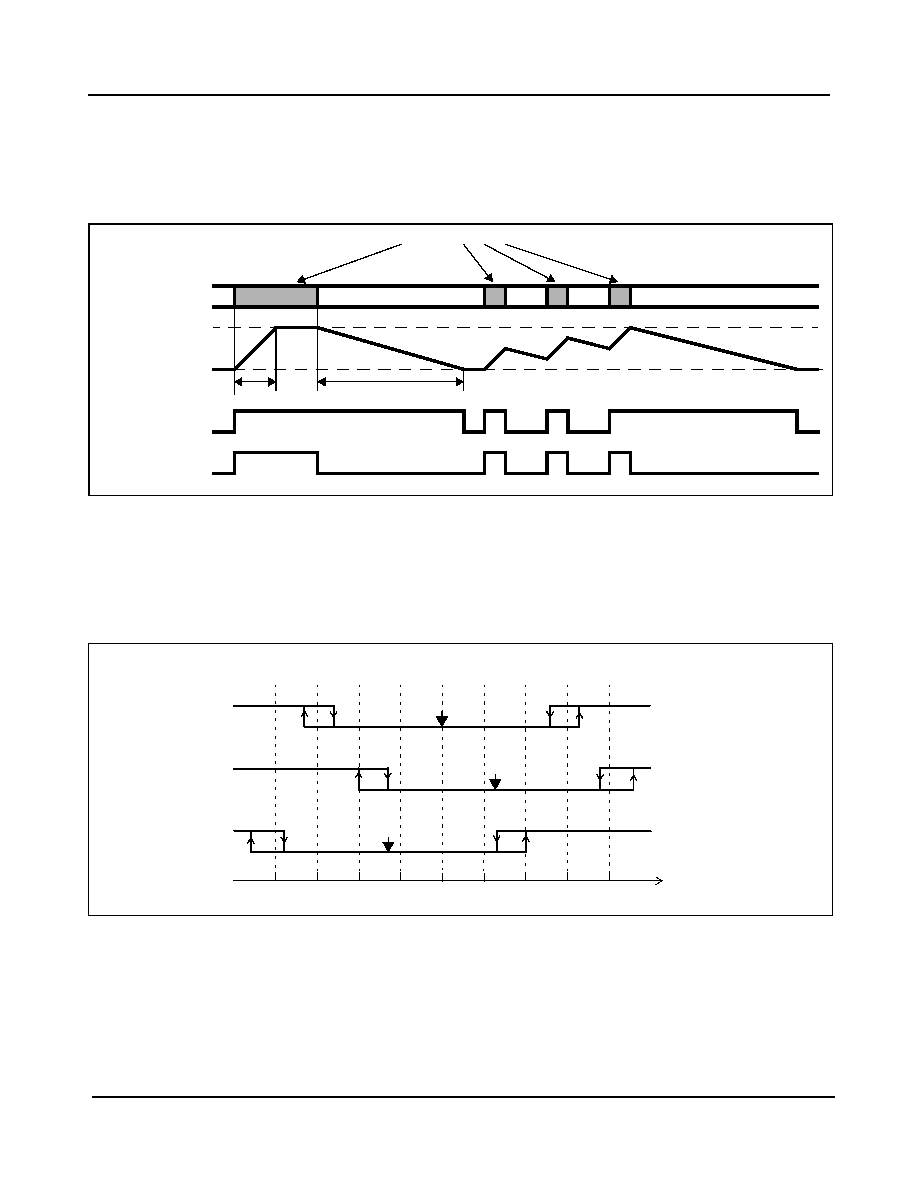
ZL30108
Data Sheet
8
Zarlink Semiconductor Inc.
Exceeding the threshold of any of the monitors forces the corresponding REF_FAIL pin to go high. The single cycle
and coarse frequency failure flags force the DPLL into Holdover mode and feed a timer that disqualifies the
reference input signal when the failures are present for more than 2.5 s. The single cycle and coarse frequency
failures must be absent for 10 s to let the timer requalify the input reference signal as valid. Multiple failures of less
than 2.5 s each have an accumulative effect and will disqualify the reference. This is illustrated in Figure 4.
Figure 4 - Behavior of the Dis/Requalify Timer
When the incoming signal returns to normal (REF_FAIL=0), the DPLL returns to Normal mode with the output
signal locked to the input signal. Each of the monitors has a built-in hysteresis to prevent flickering of the REF_FAIL
status pin at the threshold boundaries. The precise frequency monitor and the timer do not affect the mode
(Holdover/Normal) of the DPLL.
Figure 5 - Out-of-Range Thresholds for OOR_SEL=1
2.5 s
10 s
current REF
timer
REF_FAIL
SCM or CFM failure
HOLDOVER
C20i Clock Accuracy
0 ppm
+32 ppm
-32 ppm
0
51
83
64
32
32
-32
-96
-75
-50
0
-25
25
75
Frequency offset [ppm]
Out of Range
Out of Range
Out of Range
In Range
In Range
In Range
C20
50
-64
-83
115
96
-32
-51
-115
C20
C20
100
-100

ZL30108
Data Sheet
9
Zarlink Semiconductor Inc.
Figure 6 - Out-of-Range Thresholds for OOR_SEL=0
2.3 Time Interval Error (TIE) Corrector Circuit
The TIE Corrector Circuit eliminates phase transients on the output clock that may occur in the course of recovery
from Automatic Holdover mode to Normal mode.
On recovery from Automatic Holdover mode or when switching to another reference input, the TIE corrector circuit
measures the phase delay between the current phase (feedback signal) and the phase of the selected reference
signal. This delay value is stored in the TIE corrector circuit. This circuit creates a new virtual reference signal that
is at the same phase position as the feedback signal. By using the virtual reference, the PLL minimizes the phase
transient it experiences when it switches to another reference input or recovers from Automatic Holdover mode.
The delay value can be reset by setting the TIE Corrector Circuit Clear pin (TIE_CLR) low for at least 15 ns. This
results in a phase alignment between the input reference signal and the output clocks and frame pulses as shown
in Figure 15 and Figure 16. The speed of the phase alignment correction is limited by the loop filter bandwidth.
Convergence is always in the direction of least phase travel. TIE_CLR can be kept low continuously. In that case
the output clocks will always align with the selected input reference. This is illustrated in Figure 7.
C20i Clock Accuracy
0 ppm
+20 ppm
-20 ppm
0
20
52
40
20
32
-32
-60
-75
-50
0
-25
25
75
Frequency offset [ppm]
Out of Range
Out of Range
Out of Range
In Range
In Range
In Range
C20
50
-40
-52
72
60
-20
-32
-72
C20
C20
100
-100
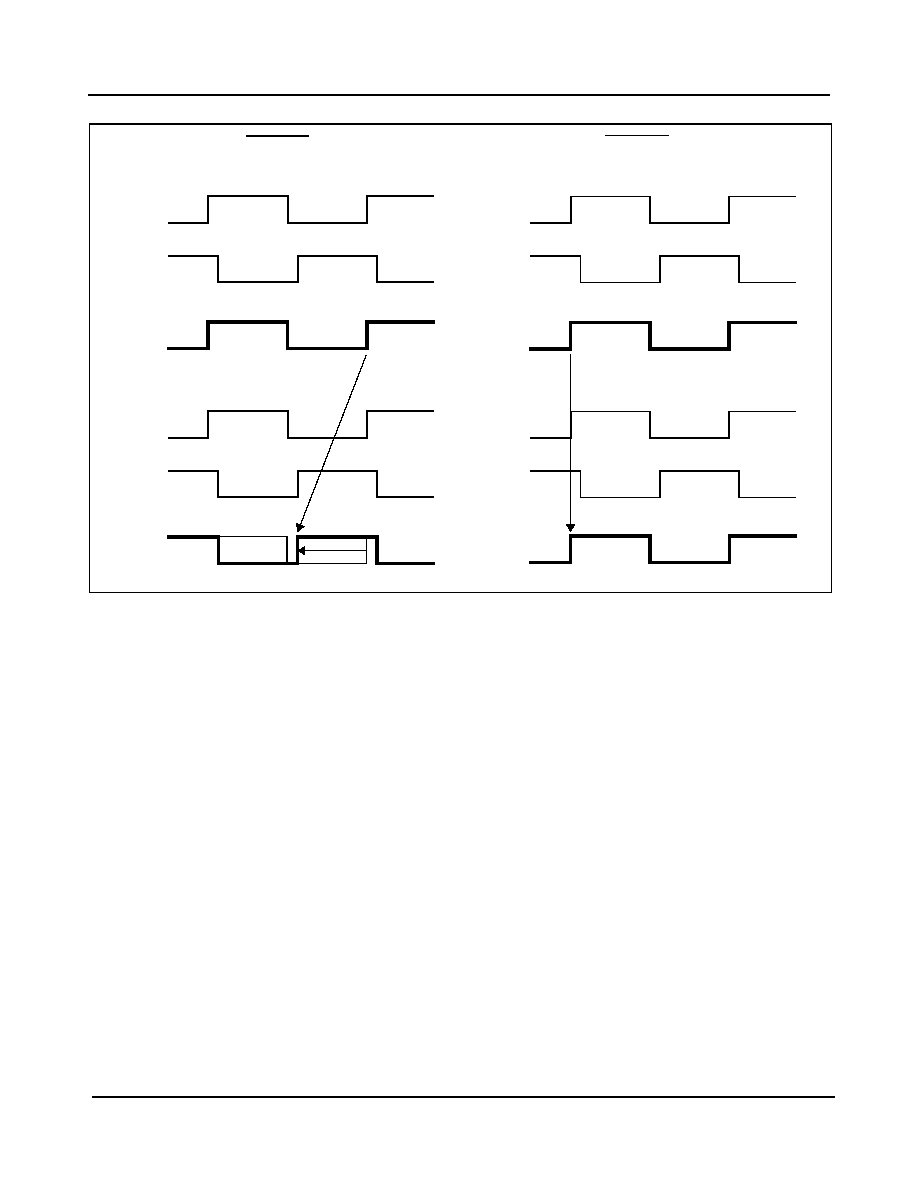
ZL30108
Data Sheet
10
Zarlink Semiconductor Inc.
Figure 7 - Timing Diagram of Hitless Reference Switching
locked to REF1
REF0
Output
Clock
TIE_CLR = 1
TIE_CLR = 0
REF1
REF0
Output
Clock
REF1
locked to REF1
REF0
Output
Clock
REF1
REF0
Output
Clock
REF1
locked to REF0
locked to REF0
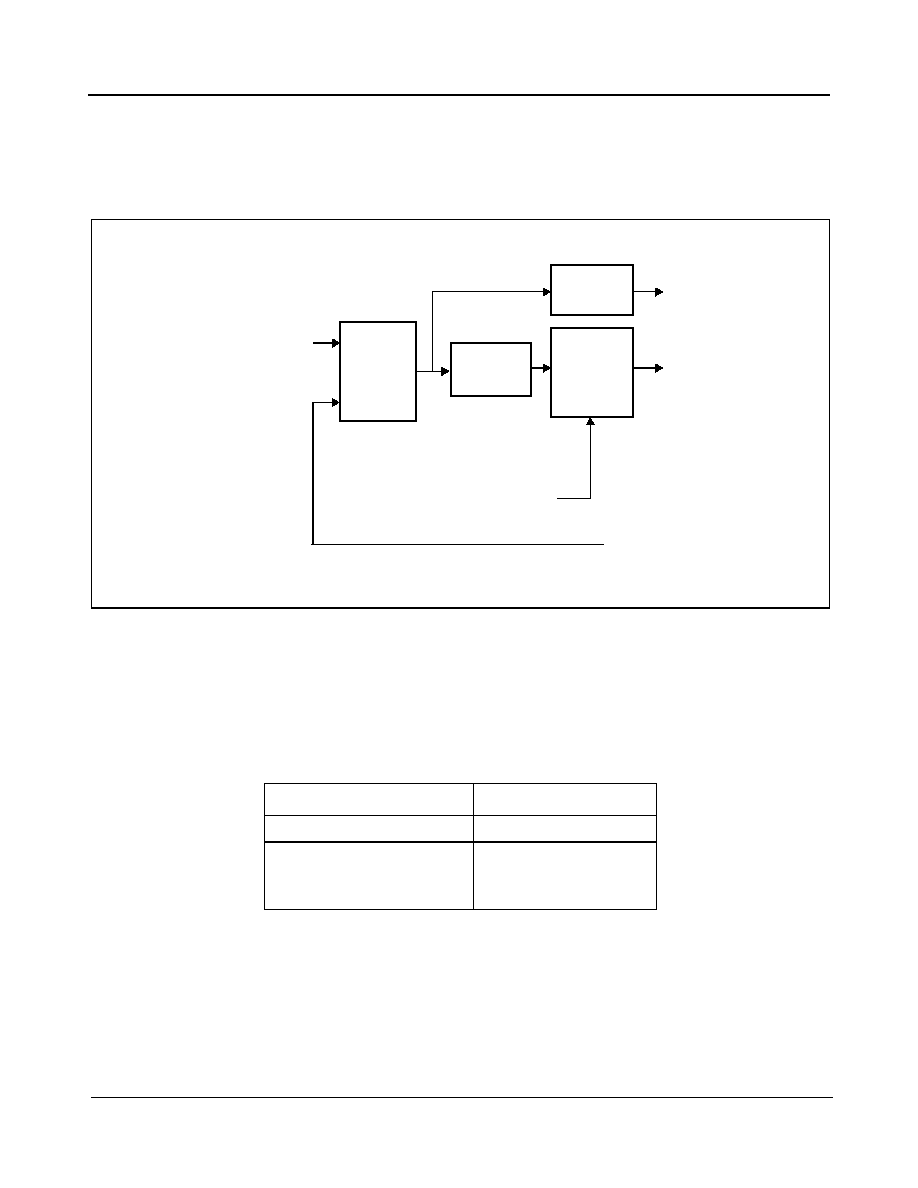
ZL30108
Data Sheet
11
Zarlink Semiconductor Inc.
2.4 Digital Phase Lock Loop (DPLL)
The DPLL of the ZL30108 consists of a phase detector, a integrated on-chip loop filter and an digitally controlled
oscillator as shown in Figure 8. The data path from the phase detector to the filter is tapped and routed to the lock
indicator that provides a lock indication which is output at the LOCK pin.
Figure 8 - DPLL Block Diagram
Phase Detector - the phase detector compares the virtual reference signal from the TIE corrector circuit with the
feedback signal and provides an error signal corresponding to the phase difference between the two. This error
signal is passed to the loop filter circuit.
Loop Filter - the loop filter is similar to a first order low pass filter with bandwidth of 29 Hz, suitable to provide timing
and synchronization for SONET/SDH network interface cards.
Detected REF Frequency
Loop Filter Bandwidth
2 kHz
14 Hz
8 kHz, 1.544 MHz,
2.048 MHz, 8.192 MHz,
16.384 MHz, 19.44 MHz
29 Hz
Table 1 - Loop Filter Bandwidth Settings
state select from
control state machine
feedback signal from
frequency select MUX
DPLL reference to
frequency synthesizer
virtual reference
from
TIE corrector circuit
loop filter
digitally
controlled
oscillator
phase
detector
lock
indicator
LOCK

ZL30108
Data Sheet
12
Zarlink Semiconductor Inc.
Digitally Controlled Oscillator (DCO) - the DCO receives the limited and filtered signal from the Loop Filter, and
based on its value, generates a corresponding digital output signal. The synchronization method of the DCO is
dependent on the state of the ZL30108.
In Normal Mode, the DCO provides an output signal which is frequency and phase locked to the selected input
reference signal.
In the Automatic Holdover mode, the DCO is free running at a frequency equal to the frequency that the DCO was
generating in Normal Mode. The frequency in the Automatic Holdover mode is calculated from frequency samples
stored 26 ms to 52 ms before the ZL30108 entered the Automatic Holdover mode. This ensures that the coarse
frequency monitor and the single cycle monitor have time to disqualify a bad reference before it corrupts the
holdover frequency.
In Freerun Mode, the DCO is free running with an accuracy equal to the accuracy of the OSCi 20 MHz source.
Lock Indicator - the lock detector monitors if the output value of the phase detector is within the phase-lock-
window for a certain time. The selected phase-lock-window guarantees the stable operation of the LOCK pin with
maximum network jitter and wander on the reference input. If the DPLL goes into the Automatic Holdover mode, the
LOCK pin will initially stay high for 0.1 s. If at that point the DPLL is still in the Automatic Holdover mode, the LOCK
pin will go low. In Freerun mode the LOCK pin will go low immediately.
2.5 Frequency Synthesizers
The output of the DCO is used by the frequency synthesizers to generate the output clocks and frame pulses which
are synchronized to one of the input references (REF0 or REF1).
The frequency synthesizer uses digital techniques to generate output clocks and advanced noise shaping
techniques to minimize the output jitter. The clock and frame pulse outputs have limited drive capability and should
be buffered when driving high capacitance loads.
2.6 State Machine
As shown in Figure 1, the state machine controls the TIE Corrector Circuit and the DPLL. The control of the
ZL30108 is based on the input MODE_SEL.
2.7 Master Clock
The ZL30108 can use either a clock or crystal as the master timing source. For recommended master timing
circuits, see the Applications - Master Clock section.
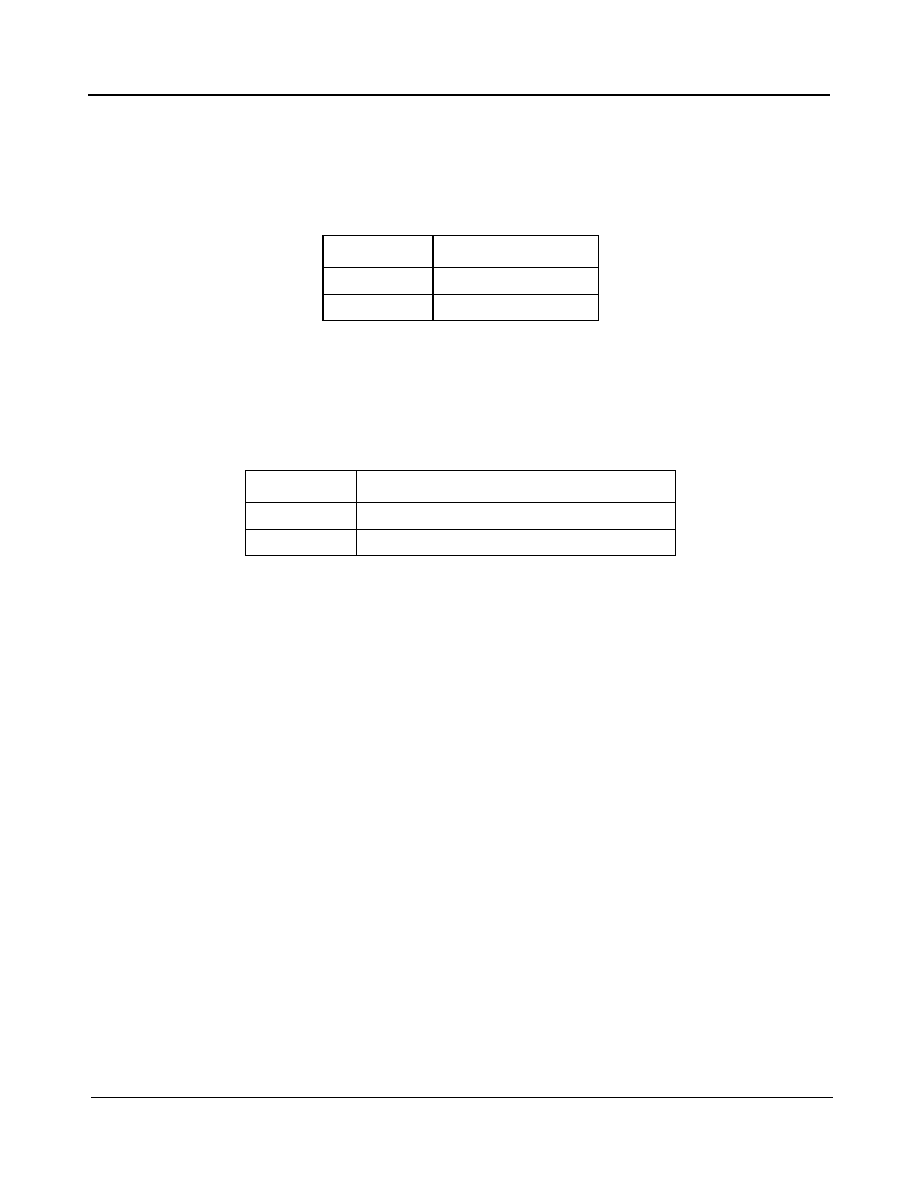
ZL30108
Data Sheet
13
Zarlink Semiconductor Inc.
3.0 Control and Modes of Operation
3.1 Out of Range Selection
The frequency out of range limits for the precise frequency monitoring in the reference monitors are selected by the
OOR_SEL pin, see Table 2.
3.2 Modes of Operation
The ZL30108 has two possible manual modes of operation; Normal and Freerun. These modes are selected with
mode select pins MODE_SEL as is shown in Table 3. Transitioning from one mode to the other is controlled
externally.
3.2.1 Freerun Mode
Freerun mode is typically used when an independent clock source is required, or immediately following system
power-up before network synchronization is achieved.
In Freerun mode, the ZL30108 provides timing and synchronization signals which are based on the master clock
frequency (supplied to OSCi pin) only, and are not synchronized to the reference input signals.
The accuracy of the output clock is equal to the accuracy of the master clock (OSCi). So if a
�
32 ppm output clock
is required, the master clock must also be
�
32 ppm. See Applications - Section 5.2, "Master Clock".
3.2.2 Normal Mode
Normal mode is typically used when a system clock source, synchronized to the network or a backplane is required.
In Normal mode, the ZL30108 provides timing and frame synchronization signals, which are synchronized to one of
two reference inputs (REF0 or REF1). The input reference signal may have a nominal frequency of 2 kHz, 8 kHz,
1.544 MHz, 2.048 MHz, 8.192 MHz, 16.384 MHz or 19.44 MHz. The frequency of the reference inputs are
automatically detected by the reference monitors.
When the Normal mode is selected through the MODE_SEL pin, the ZL30108 will automatically go into the
Automatic Holdover mode if the currently selected reference is disrupted (see Figure 9). After the power up reset,
the ZL30108 will initially go into the Automatic Holdover mode, generating clocks with the same accuracy as it
would be in the Freerun mode. If the currently selected reference is not disrupted (see Figure 3), the state machine
takes the DPLL out of the Automatic Holdover mode. The transition is done through the TIE correction state and the
current phase offset of the output signals to the input reference is maintained.
OOR_SEL
Out Of Range Limits
0
40 - 52 ppm
1
64 - 83 ppm
Table 2 - Out of Range Limits Selection
MODE_SEL
Mode
0
Normal (with automatic Holdover)
1
Freerun
Table 3 - Operating Modes

ZL30108
Data Sheet
14
Zarlink Semiconductor Inc.
If the current reference experiences an disruption while the device is in Normal mode, the device will go
automatically into Automatic Holdover mode. It will return to Normal mode as soon as the reference is valid again.
If the reference selection changes because the value of the REF_SEL pin change the ZL30108 goes into Automatic
Holdover mode and returns to Normal mode through the TIE correction state.
Figure 9 - Mode Switching in Normal Mode
Automatic Holdover Mode
Automatic Holdover mode is typically used for short durations while system synchronization is temporarily
disrupted.
In Automatic Holdover mode, the ZL30108 provides timing and synchronization signals, which are not locked to an
external reference signal, but are based on storage techniques. The storage value is determined while the device is
in Normal Mode and locked to an external reference signal.
When in Normal Mode, and locked to the input reference signal, a numerical value corresponding to the ZL30108
output reference frequency is stored alternately in two memory locations every 26 ms. When the device is switched
into Automatic Holdover mode, the value in memory from between 26 ms and 52 ms is used to set the output
frequency of the device. The frequency accuracy of Automatic Holdover mode is 0.01 ppm.
Two factors affect the accuracy of Automatic Holdover mode. One is drift on the master clock while in Automatic
Holdover mode, drift on the master clock directly affects the Automatic Holdover mode accuracy. Note that the
absolute master clock (OSCi) accuracy does not affect Holdover accuracy, only the change in OSCi accuracy while
in Holdover. For example, a
�
32 ppm master clock may have a temperature coefficient of
�
0.1 ppm per �C. So a
�
10 �C change in temperature, while the ZL30108 is in the Automatic Holdover mode may result in an additional
offset (over the 0.01 ppm) in frequency accuracy of
�
1 ppm, which is much greater than the 0.01 ppm of the
ZL30108. The other factor affecting the accuracy is large jitter on the reference input prior (26 ms to 52 ms) to the
mode switch.
REF_DIS=1: Current selected reference disrupted (see Figure 3)
REF_CH= 1: Reference change, a transition in the reference selection (a change in the
REF_SEL pin).
TIE Correction
Holdover
REF_DIS=0
REF_CH=1
REF_DIS=0 and
REF_DIS=1
(REF_DIS=0) or
REF_CH=1
REF_DIS=1
RST
REF_CH=0
Normal
(locked)

ZL30108
Data Sheet
15
Zarlink Semiconductor Inc.
3.3 Reference Selection
The active reference input (REF0 or REF1) is selected by the REF_SEL pin as shown in Table 4. If the logic value
of the REF_SEL pin is changed when the DPLL is in Normal mode, the ZL30108 will perform a hitless reference
switch.
When the REF_SEL inputs are used to force a change from the currently selected reference to another reference,
the action of the LOCK output will depend on the relative frequency and phase offset of the old and new references.
Where the new reference has enough frequency offset and/or TIE-corrected phase offset to force the output
outside the phase-lock-window, the LOCK output will de-assert, the lock-qualify timer is reset, and LOCK will stay
de-asserted for the full lock-time duration. Where the new reference is close enough in frequency and TIE-
corrected phase for the output to stay within the phase-lock-window, the LOCK output will remain asserted through
the reference-switch process.
4.0 Measures of Performance
The following are some PLL performance indicators and their corresponding definitions.
4.1 Jitter Generation (Intrinsic Jitter)
Timing jitter is defined as the high frequency variation of the clock edges from their ideal positions in time. Wander
is defined as the low-frequency variation of the clock edges from their ideal positions in time. High and low
frequency variation imply phase oscillation frequencies relative to some demarcation frequency. (Often 10 Hz or
20 Hz for DS1 or E1, higher for SONET/SDH clocks.) Jitter parameters given in this data sheet are total timing jitter
numbers, not cycle-to-cycle jitter.
4.2 Jitter Tolerance
Jitter tolerance is a measure of the ability of a PLL to operate properly (i.e., remain in lock and or regain lock in the
presence of large jitter magnitudes at various jitter frequencies) when jitter is applied to its reference. The applied
jitter magnitude and jitter frequency depends on the applicable standards.
4.3 Jitter Transfer
Jitter transfer or jitter attenuation refers to the magnitude of jitter at the output of a device for a given amount of jitter
at the input of the device. Input jitter is applied at various amplitudes and frequencies, and output jitter is measured
with various filters depending on the applicable standards. For the ZL30108, the internal low pass loop filter
determines the jitter attenuation.
Since intrinsic jitter is always present, jitter attenuation will appear to be lower for small input jitter signals than for
large ones. Consequently, accurate jitter transfer function measurements are usually made with large input jitter
signals (for example 75% of the specified maximum tolerable input jitter).
4.4 Frequency Accuracy
Frequency accuracy is defined as the absolute accuracy of an output clock signal when it is not locked to an
external reference, but is operating in a free running mode. For the ZL30108, the Freerun accuracy is equal to the
master clock (OSCi) accuracy.
REF_SEL
(input pin)
Input Reference Selected
0
REF0
1
REF1
Table 4 - Manual Reference Selection

ZL30108
Data Sheet
16
Zarlink Semiconductor Inc.
4.5 Holdover Accuracy
Holdover accuracy is defined as the absolute frequency accuracy of an output clock signal, when it is not locked to
an external reference signal, but is operating using storage techniques. For the ZL30108, the storage value is
determined while the device is in Normal Mode and locked to an external reference signal.
4.6 Capture Range
Also referred to as pull-in range. This is the input frequency range over which the PLL must be able to pull into
synchronization. The ZL30108 capture range is equal to
�
130 ppm minus the accuracy of the master clock (OSCi).
For example, a +32 ppm master clock results in a capture range of +162 ppm on one side and -98 ppm on the other
side of frequency range.
4.7 Lock Range
This is the input frequency range over which the synchronizer must be able to maintain synchronization. The lock
range is equal to the capture range for the ZL30108.
4.8 Time Interval Error (TIE)
TIE is the time delay between a given timing signal and an ideal timing signal.
4.9 Maximum Time Interval Error (MTIE)
MTIE is the maximum peak to peak delay between a given timing signal and an ideal timing signal within a
particular observation period.
4.10 Phase Continuity
Phase continuity is the phase difference between a given timing signal and an ideal timing signal at the end of a
particular observation period. Usually, the given timing signal and the ideal timing signal are of the same frequency.
Phase continuity applies to the output of the PLL after a signal disturbance due to a reference switch or a mode
change. The observation period is usually the time from the disturbance, to just after the synchronizer has settled to
a steady state.
4.11 Phase Lock Time
This is the time it takes the PLL to phase lock to the input signal. Phase lock occurs when the input signal and
output signal are aligned in phase with respect to each other within a certain phase distance (not including jitter).
Lock time is affected by many factors which include:
� initial input to output phase difference
� initial input to output frequency difference
� PLL loop filter bandwidth
� in-lock phase distance
The presence of input jitter makes it difficult to define when the PLL is locked as it may not be able to align its output
to the input within the required phase distance, dependent on the PLL bandwidth and the input jitter amplitude and
frequency.
Although a short lock time is desirable, it is not always possible to achieve due to other synchronizer requirements.
For instance, better jitter transfer performance is achieved with a lower frequency loop filter which increases lock
time. See Section 6.2, "Performance Characteristics" for Maximum Phase Lock Time.
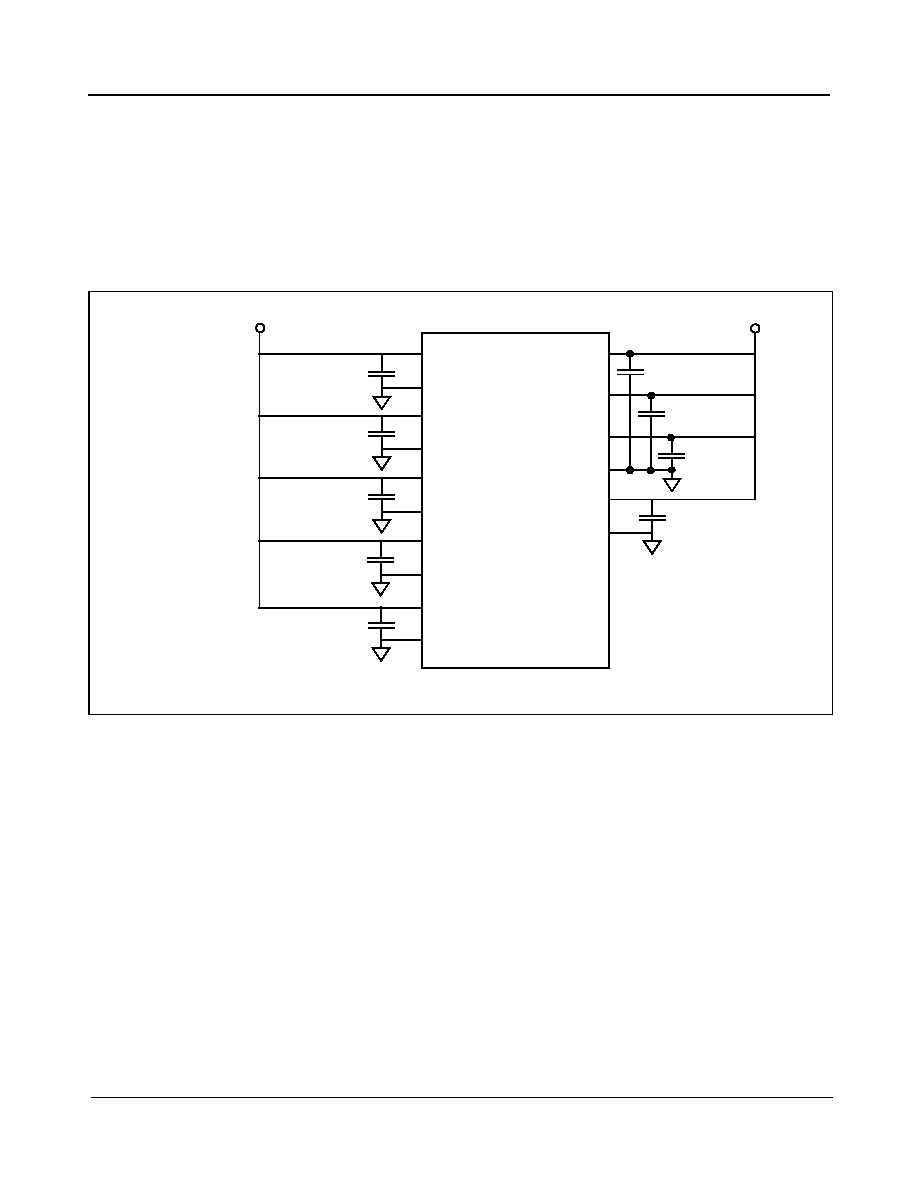
ZL30108
Data Sheet
17
Zarlink Semiconductor Inc.
5.0 Applications
This section contains ZL30108 application specific details for power supply decoupling, clock and crystal operation,
reset operation,and control operation.
5.1 Power Supply Decoupling
It is recommended to place a 100 nF decoupling capacitor close to the power and ground pairs as shown in Figure
11 to ensure optimal jitter performance.
Figure 10 - Recommended Power Supply Decoupling
100 nF
25
AGND
31
V
DD
14
V
DD
V
CORE
6
AV
CORE
18
GND
1
AV
CORE
7
1.8 V
3.3 V
19
AV
DD
15
AV
DD
100 nF
100 nF
23
AV
DD
22
AGND
17
AGND
ZL30108
100 nF
100 nF
GND
8
V
CORE
2
100 nF
1
GND
100 nF
16
GND
100 nF
100 nF
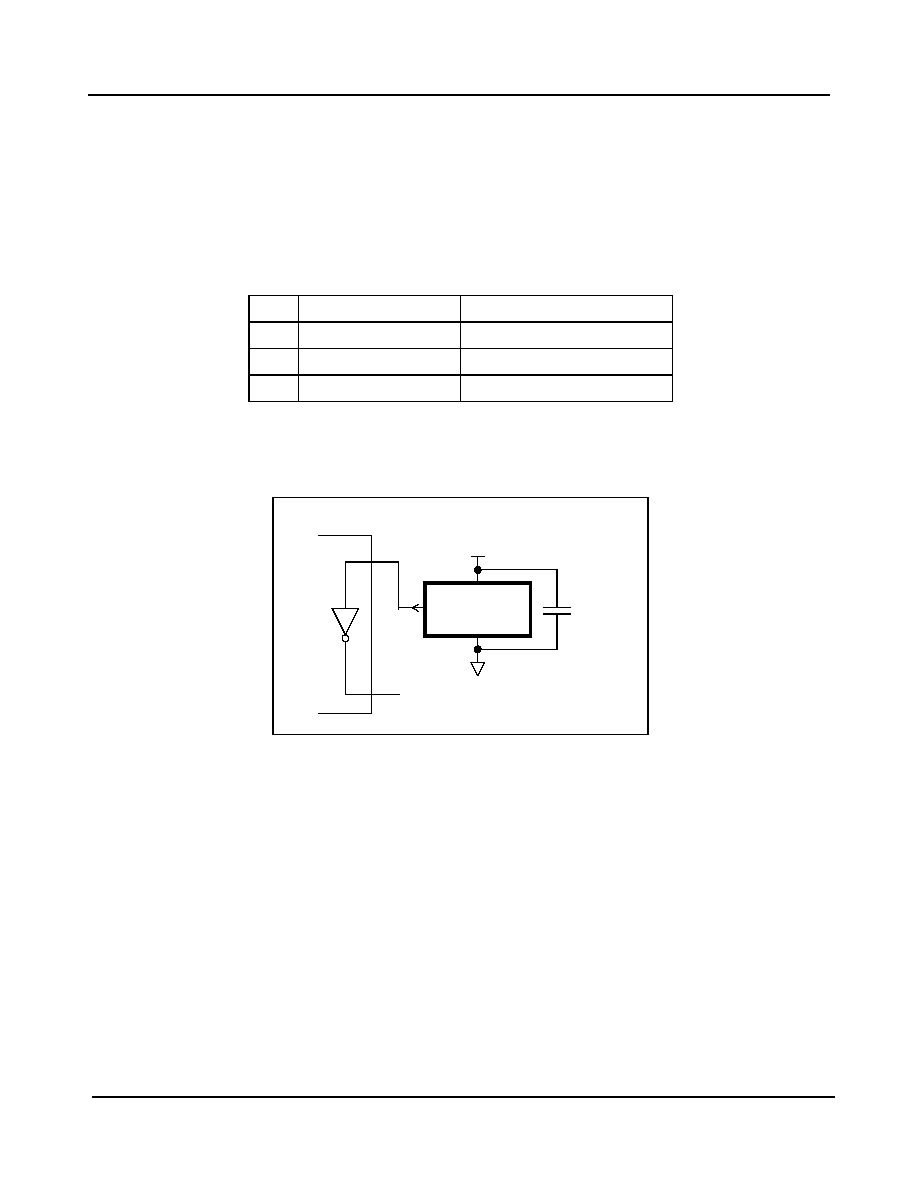
ZL30108
Data Sheet
18
Zarlink Semiconductor Inc.
5.2 Master Clock
The ZL30108 can use either a clock or crystal as the master timing source. Zarlink Application Note ZLAN-68 lists a
number of applicable oscillators and crystals that can be used with the ZL30108.
5.2.1 Clock Oscillator
When selecting a Clock Oscillator, numerous parameters must be considered. These includes absolute frequency,
frequency change over temperature, output rise and fall times, output levels, duty cycle and phase noise.
The output clock should be connected directly (not AC coupled) to the OSCi input of the ZL30108 and the OSCo
output should be left open as shown in Figure 11.
Figure 11 - Clock Oscillator Circuit
1
Frequency
20 MHz
2
Tolerance
As required
3
Rise & Fall Time
<10 ns
4
Duty Cycle
40% to 60%
Table 5 - Typical Clock Oscillator Specification
+3.3 V
20 MHz OUT
GND
0.1 �F
+3.3 V
OSCo
ZL30108
OSCi
No Connection
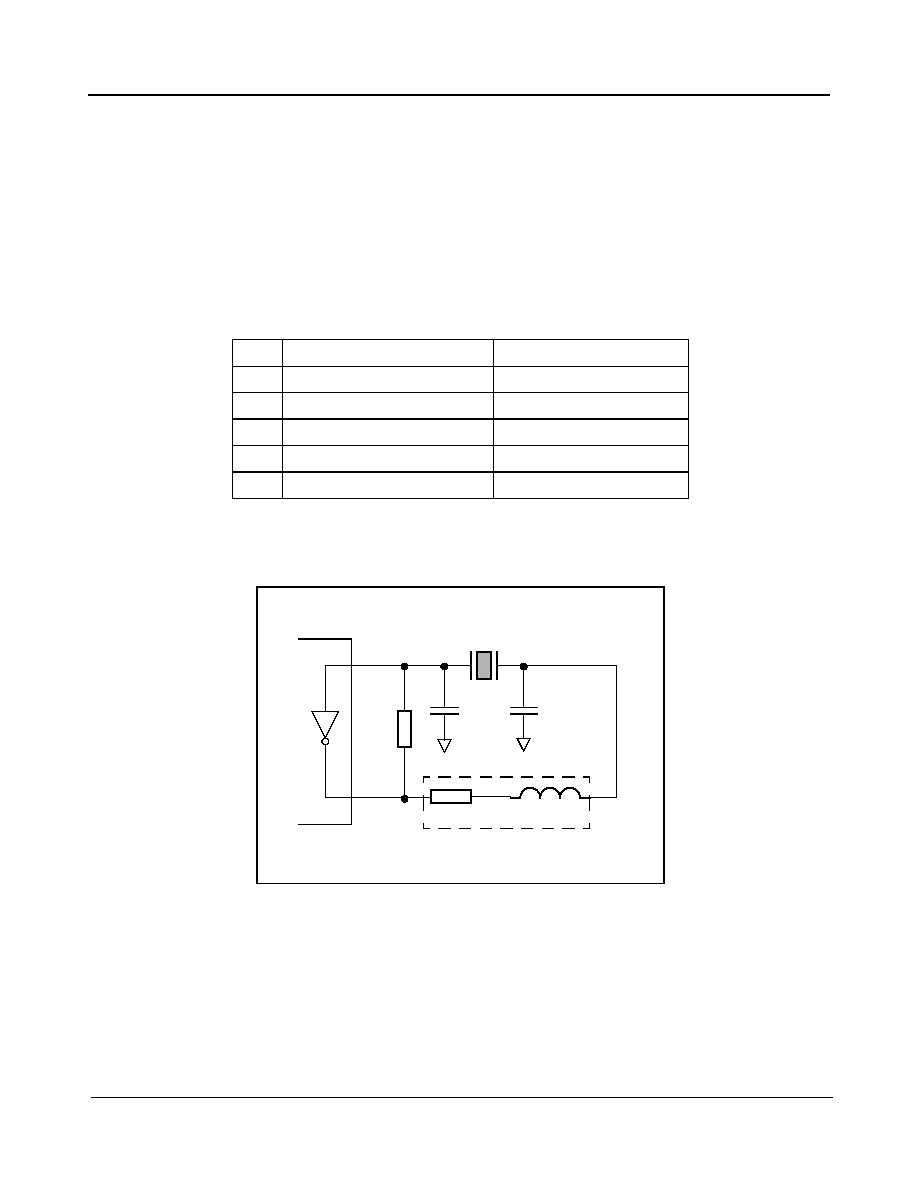
ZL30108
Data Sheet
19
Zarlink Semiconductor Inc.
5.2.2 Crystal Oscillator
Alternatively, a Crystal Oscillator may be used. A complete oscillator circuit made up of a crystal, resistor and
capacitors is shown in Figure 12.
The accuracy of a crystal oscillator depends on the crystal tolerance as well as the load capacitance tolerance.
Typically, for a 20 MHz crystal specified with a 32 pF load capacitance, each 1 pF change in load capacitance
contributes approximately 9 ppm to the frequency deviation. Consequently, capacitor tolerances and stray
capacitances have a major effect on the accuracy of the oscillator frequency.
The crystal should be a fundamental mode type - not an overtone. The fundamental mode crystal permits a simpler
oscillator circuit with no additional filter components and is less likely to generate spurious responses. The crystal
specification is as follows.
Figure 12 - Crystal Oscillator Circuit
1
Frequency
20 MHz
2
Tolerance
As required
3
Oscillation Mode
Fundamental
4
Resonance Mode
Parallel
5
Load Capacitance
As required
6
Maximum Series Resistance
50
Table 6 - Typical Crystal Oscillator Specification
OSCo
1 M
20 MHz
ZL30108
OSCi
100
1 �H
The 100
resistor and the 1 �H inductor may improve
stability and are optional.
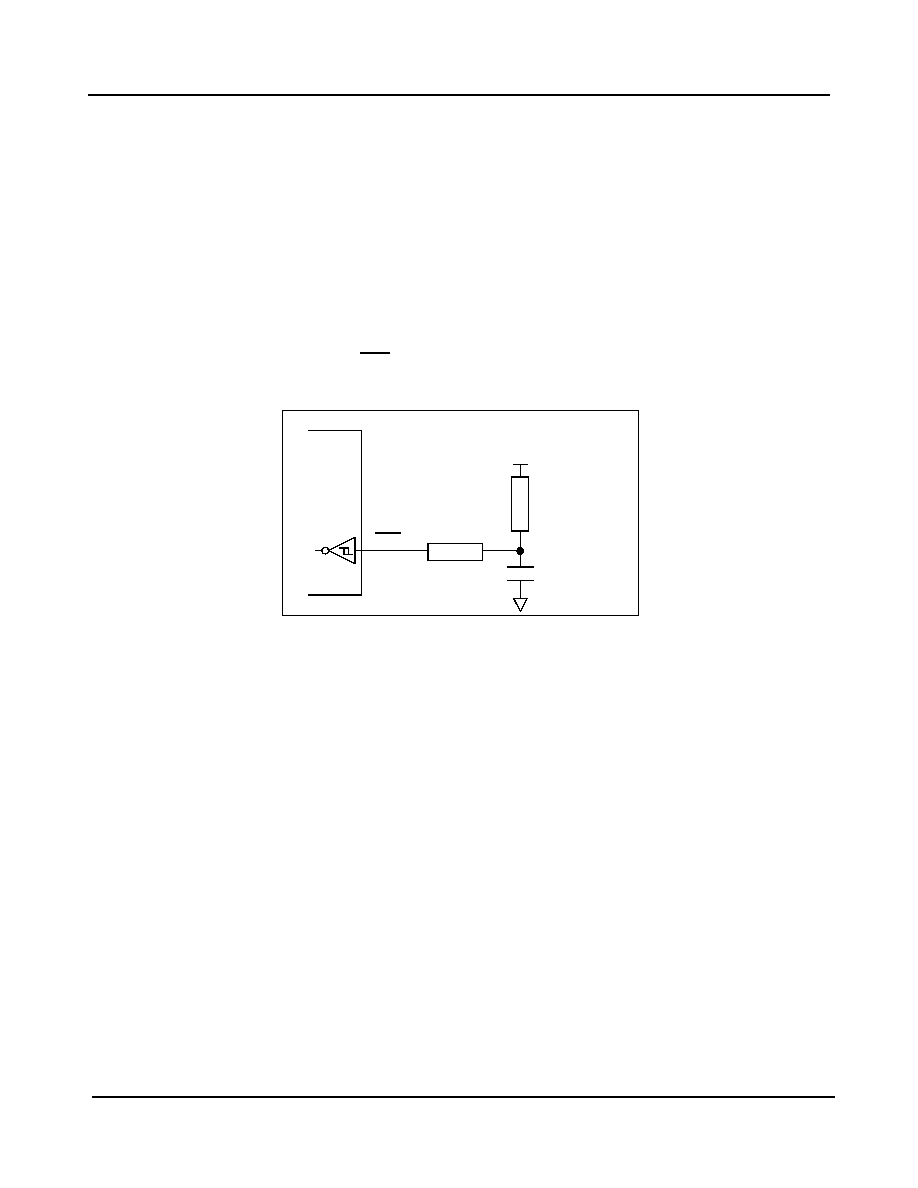
ZL30108
Data Sheet
20
Zarlink Semiconductor Inc.
5.3 Power Up Sequence
The ZL30108 requires that the 3.3 V is not powered after the 1.8 V. This is to prevent the risk of latch-up due to the
presence of parasitic diodes in the IO pads.
Two options are given:
1. Power-up 3.3 V first, 1.8 V later
2. Power up 3.3 V and 1.8 V simultaneously ensuring that the 3.3 V power is never lower than 1.8 V minus a few
hundred millivolts (e.g., by using a schottky diode or controlled slew rate)
5.4 Reset Circuit
A simple power up reset circuit with about a 300 us reset low time is shown in Figure 13. Resistor R
P
is for
protection only and limits current into the RST pin during power down conditions. The reset low time is not critical
but should be greater than 300 ns.
Figure 13 - Power-Up Reset Circuit
+3.3 V
RST
R
P
1 k
C
10 nF
R
10 k
ZL30108
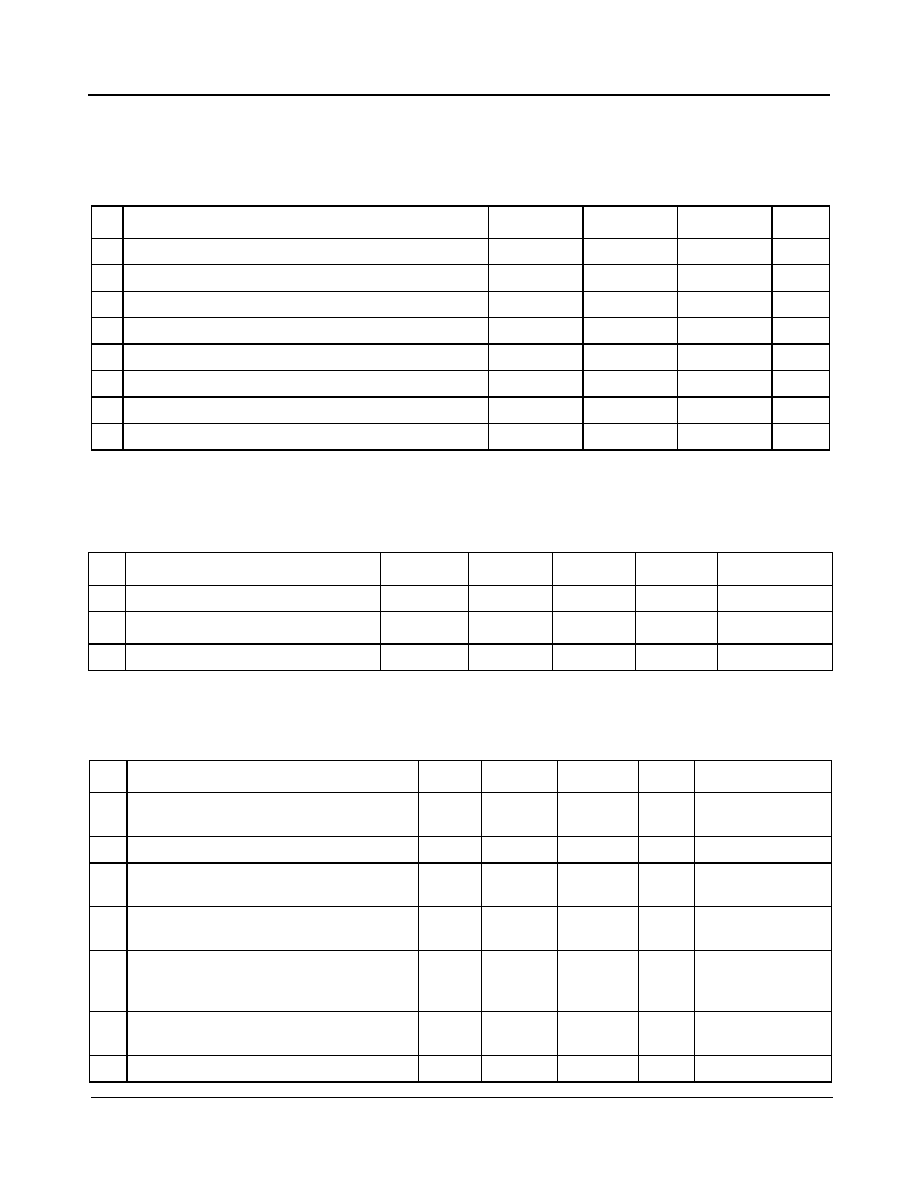
ZL30108
Data Sheet
21
Zarlink Semiconductor Inc.
6.0 Characteristics
6.1 AC and DC Electrical Characteristics
* Exceeding these values may cause permanent damage. Functional operation under these conditions is not implied.
* Voltages are with respect to ground (GND) unless otherwise stated
* Voltages are with respect to ground (GND) unless otherwise stated.
Absolute Maximum Ratings*
Parameter
Symbol
Min.
Max.
Units
1
Supply voltage
V
DD_R
-0.5
4.6
V
2
Core supply voltage
V
CORE_R
-0.5
2.5
V
3
Voltage on any digital pin
V
PIN
-0.5
6
V
4
Voltage on OSCi and OSCo pin
V
OSC
-0.3
V
DD
+ 0.3
V
5
Current on any pin
I
PIN
30
mA
6
Storage temperature
T
ST
-55
125
� C
7
Package power dissipation
P
PD
195
mW
8
ESD rating
V
ESD
2k
V
Recommended Operating Conditions*
Characteristics
Sym.
Min.
Typ.
Max.
Units
1
Supply voltage
V
DD
2.97
3.30
3.63
V
2
Core supply voltage
V
CORE
1.62
1.80
1.98
V
3
Operating temperature
T
A
-40
25
85
�C
DC Electrical Characteristics*
Characteristics
Sym.
Min.
Max.
Units
Notes
1
Supply current with: OSCi = 0 V
I
DDS
2.5
7.0
mA
outputs loaded
with 30 pf
2
OSCi = Clock
I
DD
43
mA
Outputs unloaded
3
Core supply current with: OSCi = 0 V
I
CORES
20
uA
4
OSCi = Clock
I
CORES
18
mA
5
Schmitt trigger Low to High threshold
point
V
CIH
1.47
1.85
V
All device inputs
are Schmitt trigger
type.
6
Schmitt trigger High to Low threshold
point
V
CIL
0.8
1.1
V
7
Input leakage current
I
IL
-105
105
�A
V
I
=V
DD
or 0 V
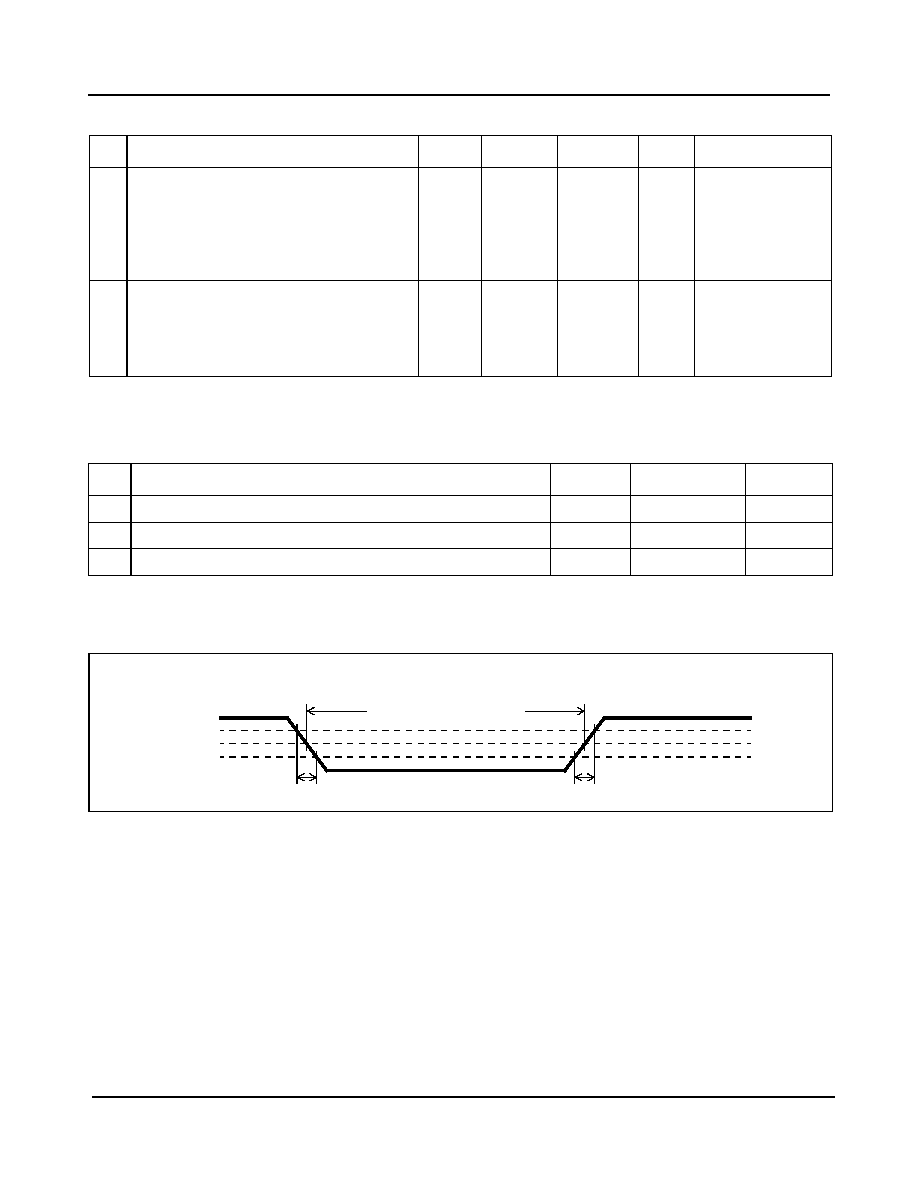
ZL30108
Data Sheet
22
Zarlink Semiconductor Inc.
* Supply voltage and operating temperature are as per Recommended Operating Conditions.
* Voltages are with respect to ground (GND) unless otherwise stated.
* Supply voltage and operating temperature are as per Recommended Operating Conditions.
* Voltages are with respect to ground (GND) unless otherwise stated.
Figure 14 - Timing Parameter Measurement Voltage Levels.
8
High-level output voltage
V
OH
2.4
V
I
OH
= 8 mA for
clock and frame-
pulse outputs,
4 mA for status
outputs
9
Low-level output voltage
V
OL
0.4
V
I
OL
= 8 mA for
clock and frame-
pulse outputs,
4 mA for status
outputs
AC Electrical Characteristics* - Timing Parameter Measurement Voltage Levels (see Figure 14).
Characteristics
Sym.
CMOS
Units
1
Threshold Voltage
V
T
1.5
V
2
Rise and Fall Threshold Voltage High
V
HM
2.0
V
3
Rise and Fall Threshold Voltage Low
V
LM
0.8
V
DC Electrical Characteristics*
Characteristics
Sym.
Min.
Max.
Units
Notes
t
IRF,
t
ORF
Timing Reference Points
ALL SIGNALS
V
HM
V
T
V
LM
t
IRF,
t
ORF

ZL30108
Data Sheet
23
Zarlink Semiconductor Inc.
* Supply voltage and operating temperature are as per Recommended Operating Conditions.
* Period Min/Max values are the limits to avoid a single-cycle fault detection. Short-term and long-term average periods must be within Out-of-
Range limits.
* Supply voltage and operating temperature are as per Recommended Operating Conditions.
AC Electrical Characteristics* - Input timing for REF0 and REF1 references (see Figure 15).
Characteristics
Symbol
Min.
Typ.
Max.
Units
1
2 kHz reference period
t
REF2kP
483
500
516
�s
2
8 kHz reference period
t
REF8kP
120
125
128
�s
3
1.544 MHz reference period
t
REF1.5P
338
648
950
ns
4
2.048 MHz reference period
t
REF2P
263
488
712
ns
5
8.192 MHz reference period
t
REF8P
63
122
175
ns
6
16.384 MHz reference period
t
REF16P
38
61
75
ns
7
19.44 MHz reference period
t
REF8kP
38
51
75
ns
8
reference pulse width high or low
t
REFW
15
ns
AC Electrical Characteristics* - Input to output timing for REF0 and REF1 references (see Figure 15).
Characteristics
Symbol
Min.
Max.
Units
1
2 kHz reference input to F2ko delay
t
REF2kD
0
1.2
ns
2
2 kHz reference input to F8ko delay
t
REF2k_F8kD
-27.2
-26.5
ns
3
8 kHz reference input to F8ko delay
t
REF8kD
-0.3
2
ns
4
1.544 MHz reference input to F8ko delay
t
REF1.5_F8kD
-1.1
0.9
ns
5
2.048 MHz reference input to F8ko delay
t
REF2_F8kD
-1.1
0.9
ns
6
8.192 MHz reference input to F8ko delay
t
REF8_F8kD
-0.6
0.8
ns
7
16.384 MHz reference input to F8ko delay
t
REF16_F8kD
29.0
30.6
ns
8
19.44 MHz reference input to C19o delay
t
REF19D
0.2
1.1
ns
9
19.44 MHz reference input to F8ko delay
t
REF19_F8kD
-1.7
1
ns

ZL30108
Data Sheet
24
Zarlink Semiconductor Inc.
Figure 15 - Input to Output Timing
* Supply voltage and operating temperature are as per Recommended Operating Conditions.
Figure 16 - SONET/SDH Output Timing Referenced to F8ko
AC Electrical Characteristics* - Output Timing (see Figure 16).
Characteristics
Sym.
Min.
Max.
Units
1
C19o delay
t
C19D
-1.0
0.5
ns
2
C19o pulse width low
t
C19L
25.0
25.8
ns
3
F2ko delay
t
F2kD
25.0
26.6
ns
4
F2ko pulse width high
t
F2kH
51.1
52
ns
5
F8ko pulse width high
t
F8kH
30.0
31.8
ns
7
Output clock and frame pulse rise or fall time
(with 30 pF load)
t
ORF
1.1
2.3
ns
REF0/1
t
REF<xx>P
t
REF8D
, t
REF<xx>_F8kD
t
REFW
t
REF<xx>D
t
REFW
F8ko
output clock with
the same frequency
as REF
F8ko
t
C19D
t
F2D
C19o
F2ko
t
C19L
t
F2kH
t
F8kH

ZL30108
Data Sheet
25
Zarlink Semiconductor Inc.
* Supply voltage and operating temperature are as per Recommended Operating Conditions.
6.2 Performance Characteristics
* Supply voltage and operating temperature are as per Recommended Operating Conditions.
AC Electrical Characteristics* - OSCi 20 MHz Master Clock Input
Characteristics
Sym.
Min.
Typ.
Max.
Units
Notes
1
Oscillator Tolerance
-20
+20
ppm
OOR_SEL=0
2
-32
+32
ppm
OOR_SEL=1
4
Duty cycle
40
60
%
5
Rise time
10
ns
6
Fall time
10
ns
Performance Characteristics* - Functional
Characteristics
Min.
Typ.
Max.
Units
Notes
1
Holdover accuracy
0.01
ppm
2
Holdover stability
NA
ppm
Determined by stability of
the 20 MHz Master Clock
oscillator
3
Capture range
-130
+130
ppm
The 20 MHz Master Clock
oscillator set at 0.ppm
4
Reference Out of Range
Threshold (including hysteresis)
-64
-83
+64
+83
ppm
The 20 MHz Master Clock
oscillator set at 0 ppm
and OOR_SEL=1
6
-40
-52
+40
+52
ppm
The 20 MHz Master Clock
oscillator set at 0 ppm
and OOR_SEL=0
Lock Time
7
14 Hz Filter
1.5
s
input reference = 2 kHz,
�100 ppm frequency
offset
8
29 Hz Filter
1
s
input reference
2 kHz,
�100 ppm frequency
offset
Output Phase Continuity (MTIE)
11
Reference switching
13
ns
12
Switching from Normal mode to
Automatic Holdover mode
0
ns
13
Switching from Automatic
Holdover mode to Normal mode
13
ns

ZL30108
Data Sheet
26
Zarlink Semiconductor Inc.
Performance Characteristics*: Measured Output Jitter -
GR-253-CORE
and
T1.105.03
conformance
* Supply voltage and operating temperature are as per Recommended Operating Conditions
Performance Characteristics*: Measured Output Jitter -
G.813
conformance (Option 1 and Option 2
* Supply voltage and operating temperature are as per Recommended Operating Conditions
* Supply voltage and operating temperature are as per Recommended Operating Conditions.
Signal
Telcordia GR-253-CORE and ANSI T1.105.03
Jitter Generation Requirements
ZL30108
Maximum Jitter
Generation
Units
Jitter
Measurement
Filter
Limit in
UI
(1 UI = 6.4 ns)
Equivalent limit
in time domain
OC-3 Interface
1
C19o
65 kHz to 1.3 MHz
0.15 UI
pp
0.96
0.22
ns
pp
2
12 kHz to1.3 MHz
(Category II)
0.1 UI
pp
0.64
0.22
ns
pp
0.01 UI
rms
64
24
ps
rms
3
500 Hz to 1.3 MHz
1.5 UI
pp
9.65
0.22
ns
pp
Signal
ITU-T G.813
Jitter Generation Requirements
ZL30108
Maximum Jitter
Generation
Units
Jitter
Measurement
Filter
Limit in
UI
(1 UI = 6.4 ns)
Equivalent limit
in time domain
STM-1 Option 1 Interface
1
C19o
65 kHz to 1.3 MHz
0.1 UI
pp
0.64
0.22
ns
pp
2
500 Hz to 1.3 MHz
0.5 UI
pp
3.22
0.22
ns
pp
STM-1 Option 2 Interface
3
C19o
12 kHz to1.3 MHz
0.1 UI
pp
0.64
0.22
ns
pp
Performance Characteristics* - Unfiltered Intrinsic Jitter
Signal
Max.
[ns
pp
]
Notes
1
C19o (19.44 MHz)
0.5
2
F8ko (8 kHz)
0.5
3
F2ko (2 kHz)
0.5


www.zarlink.com
Information relating to products and services furnished herein by Zarlink Semiconductor Inc. or its subsidiaries (collectively "Zarlink") is believed to be reliable.
However, Zarlink assumes no liability for errors that may appear in this publication, or for liability otherwise arising from the application or use of any such
information, product or service or for any infringement of patents or other intellectual property rights owned by third parties which may result from such application or
use. Neither the supply of such information or purchase of product or service conveys any license, either express or implied, under patents or other intellectual
property rights owned by Zarlink or licensed from third parties by Zarlink, whatsoever. Purchasers of products are also hereby notified that the use of product in
certain ways or in combination with Zarlink, or non-Zarlink furnished goods or services may infringe patents or other intellectual property rights owned by Zarlink.
This publication is issued to provide information only and (unless agreed by Zarlink in writing) may not be used, applied or reproduced for any purpose nor form part
of any order or contract nor to be regarded as a representation relating to the products or services concerned. The products, their specifications, services and other
information appearing in this publication are subject to change by Zarlink without notice. No warranty or guarantee express or implied is made regarding the
capability, performance or suitability of any product or service. Information concerning possible methods of use is provided as a guide only and does not constitute
any guarantee that such methods of use will be satisfactory in a specific piece of equipment. It is the user's responsibility to fully determine the performance and
suitability of any equipment using such information and to ensure that any publication or data used is up to date and has not been superseded. Manufacturing does
not necessarily include testing of all functions or parameters. These products are not suitable for use in any medical products whose failure to perform may result in
significant injury or death to the user. All products and materials are sold and services provided subject to Zarlink's conditions of sale which are available on request.
Purchase of Zarlink's I
2
C components conveys a licence under the Philips I
2
C Patent rights to use these components in and I
2
C System, provided that the system
conforms to the I
2
C Standard Specification as defined by Philips.
Zarlink, ZL and the Zarlink Semiconductor logo are trademarks of Zarlink Semiconductor Inc.
Copyright Zarlink Semiconductor Inc. All Rights Reserved.
TECHNICAL DOCUMENTATION - NOT FOR RESALE
For more information about all Zarlink products
visit our Web Site at



























